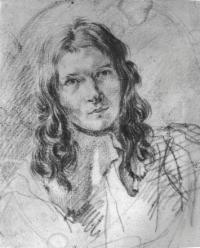 Philips Wouwerman (Haarlem, 1619-1668)
Philips Wouwerman (Haarlem, 1619-1668)Self Portrait (London, British Museum,
no. 8.11.586)
Philips Wouwerman was one of the most versatile
and prolific artists of the Dutch Golden Age.
Enbedded in the artistic environment and tradition
of his home town of Haarlem, Wouwerman made
an important and highly influential contribution
to the canon of seventeenth-century Dutch
painting.
Philips Wouwerman was a fashion painter. He
truly understood how to entice and satisfy
contemporary collectors. His paintings would
appear precisly to reflect their aesthetic
requirements and social circumstances.
With the benefit of hindsight, many of the stylistic and thematic changes in his art can be explained by changes in mode of seeing, living and collecting. He followed fashion to the letter and reflected it in the choice of subjects and style. Simultaneously Wouwerman functioned as an eclectic in grand style, who funnelled the artistic currents of his time into his pictures - often with direct reference to other painters.
In doing so, Wouwerman not only satisfied the wishes of his buyers but also reacted and reduced demand by launching new or freshly interpreted subjects. He actively created needs so as to generate renewed or additional demand for his pictures. That is how he was capable for survivng at the open art market for whom the majority of his pictures were painted for.
He knew the workings of the art market inside out and used them to full advantage from the beginning of his career. Despite the recurring economic crises and persistent social change of his time, he died a well-situated man who had guaranteed the financial security of his family.
Wouwerman commenced his career painting simple scenes drawn from quotidian military and rural life. Then, over the course of three decades, he developed a broad and multi-facetted thematic spectrum which, in its elegance and refinement, mirrored aspects of upper-class Dutch society, especially after 1650. Many of his decorative and elegant genre scenes took on stylistic and thematic characteristics now associated with the Rococo. Therefore it is hardly surprising that Wouwerman became one of the most popular Dutch artists of the 17th century with the collectors of eighteenth--century Europe.
Similarly, it is hardly astonishing that with the rise of a new, more realistic conception of landscape in the early 19th century, and a concomitantly altered reading of the art of the Golden Age, his paintings came to be thought outmoded. Although many of his finely painted pictures were and still are much beloved and sought after by collectors everywhere, art-historical scholarship until well into the 20th century neclected Wouwerman and his art.
Even so, Wouwerman's facility at rendering horses of all kinds of breeds and in all sorts of dynamic poses, has remained legendary to this day, and he is rightly ranked among the very best horse painters of all time. His achievements and triumphs as landscape and genre painter are not to be overlooked either.
His top works of the 1650's offer a ravishing combination of southern fantasy landscape with Dutch atmosphere and staffage: Uncontested are the painterly qualities of these scenes, with their aristocratic-looking staffage, delicately orchestrated colours, rich detail often combined with wit, and riches shimmering in a hazy atmosphere.